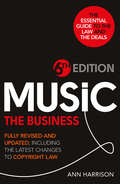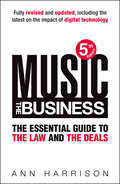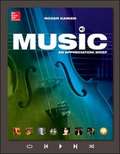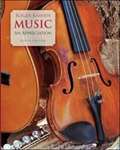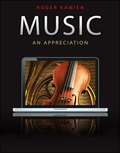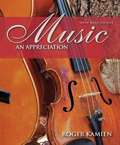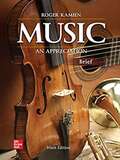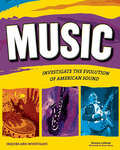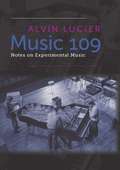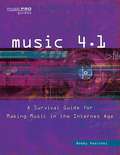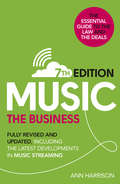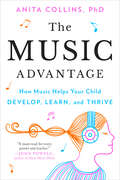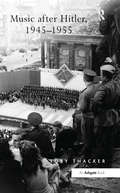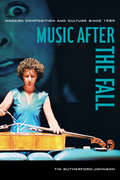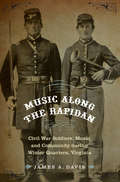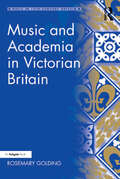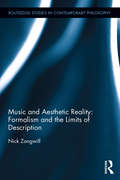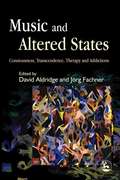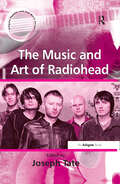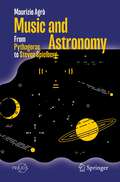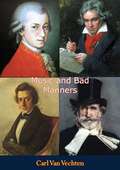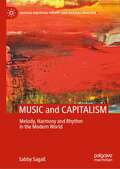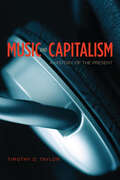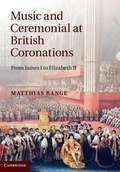- Table View
- List View
Music: Fully revised and updated, including the latest changes to Copyright law
by Ann HarrisonThis essential and highly acclaimed guide, now updated and revised in its sixth edition, explains the business of the British music industry. Drawing on her extensive experience as a media lawyer, Ann Harrison offers a unique, expert opinion on the deals, the contracts and the business as a whole. She examines in detail the changing face of the music industry and provides absorbing and up-to-date case studies. Whether you’re a recording artist, songwriter, music business manager, industry executive, publisher, journalist, media student, accountant or lawyer, this practical and comprehensive guide is indispensable reading. Fully revised and updated. Includes: The current types of record and publishing deals, and what you can expect to see in the contracts A guide to making a record, manufacture, distribution, branding, marketing, merchandising, sponsorship, band arrangements and touring The most up-to-date information on copyright law and related rights An in-depth look at digital downloads, streaming, online marketing and piracy Case studies illustrating key developments and legal jargon explained.
Music: The Essential Guide to the Law and the Deals
by Ann HarrisonThis essential and highly acclaimed guide, now updated and revised in its fifth edition, explains the possibilities and pitfalls of the British music industry, from the developments in new media, privacy, sponsorship and sampling to the expanding role of the internet and the dominance of digital music. Drawing on her extensive experience as a media lawyer, Ann Harrison offers a unique, expert opinion on the deals, the contracts and the business as a whole. She examines in detail the changing face of the music business and provides absorbing case studies of huge stars such as Robbie Williams, Ms Dynamite and Elvis Presley. Fascinating, practical and comprehensive, this is the bible for the music industry and indispensable reading for any musical entrepreneur.
Music: An Appreciation (Brief 8th Edition)
by Roger KamienMcGraw-Hill is revolutionizing the Music Appreciation course by introducing its first personalized digital learning experience with Roger Kamien's Music: An Appreciation, Brief Edition. Using this market-leading instrument that brings great music to the course in more ways than ever before, students are now transformed into active participants in the Music Appreciation space. The result is active listening, active reading, and active learning. Connect is the only integrated learning system that empowers students by continuously adapting to deliver precisely what they need, when they need it, so that your class time is more engaging and effective. It provides tools that make assessment easier, learning more engaging, and studying more efficient.
Music: An Appreciation
by Roger Kamien"This text provides an approach to perceptive listening and an introduction to musical elements, forms, and stylistic periods. Its discussions of composers' lives, individual styles, and representative works aim not merely to impart facts but to stimulate curiosity and enthusiasm. The book was written to heighten the readers' love of music as well as to develop their listening skills." - from the Preface to the Seventh Edition Through six editions, Roger Kamien's Music: An Appreciation has become the most widely used text for Music Appreciation and Introduction to Music Literature courses. The author has approached his new seventh edition with the goal of re-examining the scholarship and refreshing the repertoire while maintaining the strengths that have made the book number one - the clear presentation of musical elements, the vivid depiction of music history, the carefully chosen musical examples, the detailed and informative Listening Outlines, and the unsurpassed supplements
Music: An Appreciation (10th edition)
by Roger KamienWhat does it take to make a great performance? It takes great music, a great performer and a great instrument. Music: An appreciation examines some of the greatest music ever created. Roger Kamien's excellence as an interpreter of that music has made his program number one in the market used by over half a million students since its conception. Now, connect Kamien provides the world-class instrument that allows Music: An Appreciation to bring great music to his audience in an extraordinary new way. Music: An Appreciation is the right music, the right interpreter, and the right instrument.
Music: An Appreciation (6th Brief Edition)
by Roger KamienWhether from a concert stage or at the front of a classroom, Roger Kamien knows how to reach an audience--blending intelligence and passion to lift music from the page and bring it to life. His unique combination of artistic and teaching skills makes Music: An Appreciation, Brief Edition an invaluable tool for students wanting to learn more about music. This best-selling textbook introduces students to perceptive listening and provides an engaging introduction to musical elements, forms, and stylistic periods. It is organized chronologically, but individual sections can be addressed in any order, for a variety of teaching approaches. Musical notation is included but is not required to understand the popular listening guides featured in the text, which focus students' attention on musical events as they unfold. The Online Learning Center for this text provides open access for all students to many activities and video instrument demonstrations in addition to quiz and study materials for each chapter.
Music: An Appreciation
by Roger KamienMusic: An Appreciation welcomes non-majors to the art of listening to great music. Roger Kamien continues to focus on coverage of the elements of music, fostering each student's unique path to listening and understanding. The Brief 10th edition of Music: An Appreciation equips students with the language, tools, and listening skills required to sustain a lifelong enthusiasm for music. <p><p> Typically the first material that a Music Appreciation student encounters in the semester is about the elements of music. Often it is a student's first exposure to musical vocabulary and concepts. The new edition features four learning tools that supplement and expand on Roger Kamien's narrative on the elements. These include Elements of Music Interactives, Fundamentals of Music Video Tutorials, Spotify Playlists, and targeted guidance in Listening Outlines and Vocal Listening Guides.
Music
by Bryan Stone Donna LathamThe United States boasts a rich musical diversity. Colonial Americans integrated European traditions with new cultural influences to compose a unique musical identity. African traditions influenced hymns and folk songs that connected people to religion and to the trials and tribulations of everyday life. Patriotic tunes created unity in wartime. America's jazz, blues, rock, and hip-hop continue to evolve from their African-American origins. Music: Investigate the Evolution of American Sound invites kids ages 12 and up to explore the roots of American music genres as they investigate the social, political, and religious influences that inspire musicians. Activities encourage readers to inquire into the art and science of music. Readers can engage in a hands-on exploration of the physics of sound vibrations, decibel levels, and acoustics, or use vocal styling to improvise and discover the rhythm of their bodies to create a beatbox. Music encourages readers to analyze lyrics, their meanings, and rhythms, and then use that analysis to write their own songs. This title meets common core state standards in language arts for reading informational text and literary nonfiction and is aligned with Next Generation Science Standards. Guided Reading Levels and Lexile measurements indicate grade level and text complexity.
Music 109: Notes on Experimental Music
by Robert Ashley Alvin LucierComposer and peformer Alvin Lucier brings clarity to the world of experimental music as he takes the reader through more than a hundred groundbreaking musical works, including those of Robert Ashley, John Cage, Charles Ives, Morton Feldman, Philip Glass, Pauline Oliveros, Steve Reich, Christian Wolff, and La Monte Young. Lucier explains in detail how each piece is made, unlocking secrets of the composers' style and technique. The book as a whole charts the progress of American experimental music from the 1950s to the present, covering such topics as indeterminacy, electronics, and minimalism, as well as radical innovations in music for the piano, string quartet, and opera. Clear, approachable and lively, Music 109 is Lucier's indispensable guide to late 20th-century composition. No previous musical knowledge is required, and all readers are welcome.
Music 4. 1: A Survival Guide for Making Music in the Internet Age
by Bobby OwsinskiToday's music industry is constantly changing at a dizzying pace, and this book is fully equipped to help you navigate it. Written for artists overwhelmed by the seemingly endless options of the quickly evolving Internet, this is the only book that offers a comprehensive strategy for online success. In this book, the author includes an in-depth look at the economics of streaming music, with the real information about royalties that distributors and record labels don't want you to know and that simply can't be found anywhere else. The book also looks at how revenue is generated from YouTube and other video streaming services, and it provides techniques for optimizing both videos and channels for maximum success. Also included are lists of effective tips (both high- and low-tech) and checklists with every chapter, as well as a reference list of online tools for inexpensive music and merchandise distribution, sales, marketing, and promotion. With fresh interviews from several of today's successful music industry innovators, The book reveals new and proven pathways to success in the new paradigm of the modern music world.
Music (7th edition): Fully Revised and Updated, including the latest developments in music streaming
by Ann HarrisonThis essential and highly acclaimed guide, now updated and revised in its seventh edition, explains the business of the British music industry. Drawing on her extensive experience as a media lawyer, Ann Harrison offers a unique, expert opinion on the deals, the contracts and the business as a whole. She examines in detail the changing face of the music industry and provides absorbing and up-to-date case studies. Whether you’re a recording artist, songwriter, music business manager, industry executive, publisher, journalist, media student, accountant or lawyer, this practical and comprehensive guide is indispensable reading. Fully revised and updated. Includes: · The current types of record and publishing deals, and what you can expect to see in the contracts· A guide to making a record, manufacture, distribution, branding, marketing, merchandising, sponsorship, band arrangements and touring · The most up-to-date information on music streaming, digital downloads, online marketing and piracy· An in-depth look at copyright law and related rights· Case studies illustrating key developments and legal jargon explained.
The Music Advantage: How Music Helps Your Child Develop, Learn, and Thrive
by Dr. Anita CollinsAn expert in cognitive development and music education reveals the remarkable and surprising benefits that playing--or even appreciating--music offers to children.The latest cognitive research has revealed something extraordinary: learning music and listening to music can grow and repair our brains at any age. Here, Dr. Anita Collins explains how music has the potential to positively benefit almost all aspects of a child's development, whether it's through formal education or mindful appreciation; simply clapping in time can assist a young child who is struggling with reading. It turns out that playing music is the cognitive equivalent of a full-body workout. Dr. Collins lays out the groundbreaking research that shows how playing an instrument can improve language abilities, social skills, concentration, impulse control, emotional development, working memory, and planning and strategy competence, from infancy through adolescence. She also provides real-life stories to show the difference that music learning can make, as well as practical strategies for parents and educators to encourage a love of music in their kids.
Music after Hitler, 1945-1955
by Toby ThackerThe political control of music in the Third Reich has been analysed from several perspectives, and with ever increasing sophistication. However, music in Germany after 1945 has not received anything like the same treatment. Rather, there is an assumption that two separate musical cultures emerged in East and West alongside the division of Germany into two states with differing economic and political systems. There is a widely accepted view of music in West Germany as 'free', and in the East subject to party control. Toby Thacker challenges these assumptions, asking how and why music was controlled in Germany under Allied Occupation from 1945-1949, and in the early years of 'semi-sovereignty' between 1949 and 1955. The 're-education' of Germany after the Hitler years was a unique historical experiment and the place of music within this is explored here for the first time. While emphasizing political, economic and broader social structures that influenced the production and reception of different musical forms, the book is informed by a sense of human agency, and explores the role of salient individuals in the reconstruction of music in post-war Germany. The focus is not restricted to any one kind of music, but concentrates on those aspects of music, professional and amateur, live and recorded, which appeared to be the mostly highly charged politically to contemporaries. Particular attention is given to 'denazification' and to the introduction of international music. Thacker traces the development of a divide between Communist and liberal-democratic understandings of the place of music in society. The contested celebrations of the Bach Year in 1950 are used to highlight the role of music in the broader cultural confrontation between East and West. Thacker examines the ways in which central governments in East and West Germany sought to control and influence music through mechanisms of censorship and positive support. The book will therefore be of interest not only
Music after the Fall: Modern Composition and Culture since 1989
by Tim Rutherford-JohnsonMusic after the Fall is the first book to survey contemporary Western art music within the transformed political, cultural, and technological environment of the post–Cold War era. In this book, Tim Rutherford-Johnson considers musical composition against this changed backdrop, placing it in the context of globalization, digitization, and new media. Drawing connections with the other arts, in particular visual art and architecture, he expands the definition of Western art music to include forms of composition, experimental music, sound art, and crossover work from across the spectrum, inside and beyond the concert hall. Each chapter is a critical consideration of a wide range of composers, performers, works, and institutions, and develops a broad and rich picture of the new music ecosystem, from North American string quartets to Lebanese improvisers, from electroacoustic music studios in South America to ruined pianos in the Australian outback. Rutherford-Johnson puts forth a new approach to the study of contemporary music that relies less on taxonomies of style and technique than on the comparison of different responses to common themes of permission, fluidity, excess, and loss.
Music Along the Rapidan: Civil War Soldiers, Music, and Community during Winter Quarters, Virginia
by James A. DavisIn December 1863, Civil War soldiers took refuge from the dismal conditions of war and weather. They made their winter quarters in the Piedmont region of central Virginia: the Union’s Army of the Potomac in Culpeper County and the Confederacy’s Army of Northern Virginia in neighboring Orange County. For the next six months the opposing soldiers eyed each other warily across the Rapidan River. In Music Along the Rapidan James A. Davis examines the role of music in defining the social communities that emerged during this winter encampment. Music was an essential part of each soldier’s personal identity, and Davis considers how music became a means of controlling the acoustic and social cacophony of war that surrounded every soldier nearby. Music also became a touchstone for colliding communities during the encampment—the communities of enlisted men and officers or Northerners and Southerners on the one hand and the shared communities occupied by both soldier and civilian on the other. The music enabled them to define their relationships and their environment, emotionally, socially, and audibly.
Music and Academia in Victorian Britain (Music in Nineteenth-Century Britain)
by Rosemary GoldingUntil the nineteenth century, music occupied a marginal place in British universities. Degrees were awarded by Oxford and Cambridge, but students (and often professors) were not resident, and there were few formal lectures. It was not until a benefaction initiated the creation of a professorship of music at the University of Edinburgh, in the early nineteenth century, that the idea of music as a university discipline commanded serious consideration. The debates that ensued considered not only music’s identity as art and science, but also the broader function of the university within education and society. Rosemary Golding traces the responses of some of the key players in musical and academic culture to the problems surrounding the establishment of music as an academic discipline. The focus is on four universities: Edinburgh, Oxford, Cambridge and London. The different institutional contexts, and the approaches taken to music in each university, showcase the various issues surrounding music’s academic identity, as well as wider problems of status and professionalism. In examining the way music challenged conceptions of education and professional identity in the nineteenth century, the book also sheds light on the way the academic study of music continues to challenge modern approaches to music and university education.
Music and Aesthetic Reality: Formalism and the Limits of Description (Routledge Studies in Contemporary Philosophy)
by Nick ZangwillIn this volume, Zangwill develops a view of the nature of music and our experience of music that foregrounds the aesthetic properties of music. He focuses on metaphysical issues about aesthetic properties of music, psychological issues about the nature of musical experience, and philosophy of language issues about the metaphorical nature of aesthetic descriptions of music. Among the innovations of this book, Zangwill addresses the limits of literal description, generally, and in the aesthetic case. He also explores the social and political issues about musical listening, which tend to be addressed more in continental traditions.
Music and Altered States: Consciousness, Transcendence, Therapy and Addictions
by Lucanne Magill Tsvia Horesh David Aldridge Dalia Cohen Joerg FachnerThis international collection examines the opportunities for using music-induced states of altered consciousness to promote physical and mental healing, treat substance dependence, and in spiritual and palliative care. The contributors describe the successful use of altered states and their therapeutic potential, providing examples from different cultures and clinical, therapeutic and spiritual settings. Their observations cover a wide range of music types capable of inducing altered states, including polyrhythmic music, monotonous drumming, Western pop, and Arab musical schemata, complemented by theoretical and clinical approaches to applications in music therapy. This book will be a useful reference for practising music therapists, musicologists, and ethnomusicologists, students and academics in the field.
The Music and Art of Radiohead (Ashgate Popular And Folk Music Ser.)
by Joseph TateThe Music and Art of Radiohead provides compelling close readings of the English band's music, lyrics, album cover art and music videos as well as critical commentary on interviews, reviews and the documentary film Meeting People is Easy. Established and emerging academic scholars engage with Radiohead's music and art via concerns of broader implication to contemporary cultural studies. Topics range from the band's various musical and multivalent social contexts to their contested situation within a global market economy; from asking the question, 'how free is art?' to considering the band's musical influences and radical sonic explorations. Together, the essays form a comprehensive discussion of Radiohead's entire oeuvre, from Pablo Honey to Hail to the Thief, with a special focus on the critically acclaimed best-selling albums Kid A and Amnesiac.
Music and Astronomy: From Pythagoras to Steven Spielberg (Springer Praxis Books)
by Maurizio AgròThis book explores the profound and ancient relationship between music and astronomy. Throughout history, Music has occupied a significant place among the disciplines of the Quadrivium, which also include Geometry, Arithmetic, and Astronomy. The captivating bond between these two realms has not only inspired eminent scientists like Kepler, Newton, and Einstein, but has also captured the imagination of NASA and astronauts in modern times. The author delves into various aspects of the intersection between music and astronomy, encompassing everything from ancient cosmological beliefs to groundbreaking discoveries such as the cosmic background radiation and gravitational waves. This enthralling theme has not only stimulated renowned artists like David Bowie and Elton John, but has also served as a muse for movies like Close Encounters of the Third Kind. Within the book, readers will find an extensive photo gallery and a specially curated soundtrack that enhances the reading experience. It caters to a broad audience, appealing to those with a general interest in both music and astronomy, as well as to specialized individuals in either field of study.
Music and Bad Manners
by Carl Van Vechten“SINGERS, musicians of all kinds, are notoriously bad mannered. The storms of the Titan, Beethoven, the petty malevolences of Richard Wagner, the weak sulkiness of Chopin (“Chopin in displeasure was appalling,” writes George Sand, “and as with me he always controlled himself it was as if he might die of suffocation”) have all been recalled in their proper places in biographies and in fiction; but no attempt has been made heretofore, so far as I am aware, to lump similar anecdotes together under the somewhat castigating title I have chosen to head this article.”-IntroductionCarl Van Vechten (B.A., University of Chicago, 1903) was a photographer, music-dance critic, novelist, and patron of the Harlem Renaissance who served as literary executor for Gertrude Stein.Van Vechten was among the most influential literary figures of the 1910s and 1920s. He began his career in journalism as a reporter, then in 1906 joined The New York Times as assistant music critic and later worked as its Paris correspondent. His early reviews are collected in Interpreters and Interpretations (1917 and 1920) and Excavations: A Book of Advocacies (1926). His first novel, Peter Whiffle (1922), a first-person account of the salon and bohemian culture of New York and Paris and clearly drawn from Van Vechten's own experiences, and was immensely popular.In the 1930s, Van Vechten turned from fiction to photography. His photographs are in collections at the Museum of Modern Art in New York and elsewhere. An important literary patron, he established the James Weldon Johnson Collection of Negro Arts and Letters at Yale.
MUSIC and CAPITALISM: Melody, Harmony and Rhythm in the Modern World (Critical Political Theory and Radical Practice)
by Sabby SagallThis book argues that the need for music, and the ability to produce and enjoy it, is an essential element in human nature. Every society in history has produced some characteristic style of music. Music, like the other arts, tells us truths about the world through its impact on our emotional life. There is a structural correspondence between society and music. The emergence of 'modern art music' and its stylistic changes since the rise of capitalist social relations reflect the development of capitalist society since the decline of European feudalism. The leading composers of the different eras expressed in music the aspirations of the dominant or aspiring social classes. Changes in musical style not only reflect but in turn help to shape changes in society. This book analyses the stylistic changes in music from the emergence of ‘tonality’ in the late seventeenth century until the Second World War.
Music and Capitalism: A History of the Present (Big Issues In Music Ser.)
by Timothy D. TayloriTunes. Spotify. Pandora. With these brief words one can map the landscape of music today, but these aren't musicians, songs, or anything else actually musical--they are products and brands. In this book, Timothy D. Taylor explores just how pervasively capitalism has shaped music over the last few decades. Examining changes in the production, distribution, and consumption of music, he offers an incisive critique of the music industry's shift in focus from creativity to profits, as well as stories of those who are laboring to find and make musical meaning in the shadows of the mainstream cultural industries. Taylor explores everything from the branding of musicians to the globalization of music to the emergence of digital technologies in music production and consumption. Drawing on interviews with industry insiders, musicians, and indie label workers, he traces both the constricting forces of bottom-line economics and the revolutionary emergence of the affordable home studio, the global internet, and the mp3 that have shaped music in different ways. A sophisticated analysis of how music is made, repurposed, advertised, sold, pirated, and consumed, Music and Capitalism is a must read for anyone who cares about what they are listening to, how, and why.
Music and Ceremonial at British Coronations
by Matthias RangeCoronations are the grandest of all state occasions. This is the first comprehensive in-depth study of the music that was performed at British coronations from 1603 to the present, encompassing the sixteen coronations that have taken place in Westminster Abbey and the last two Scottish coronations. Range describes how music played a crucial role at the coronations and how the practical requirements of the ceremonial proceedings affected its structure and performance. The programme of music at each coronation is reconstructed, accompanied by a wealth of transcriptions of newly discovered primary source material, revealing findings that lead to fresh conclusions about performance practices. The coronation ceremonies are placed in their historical context, including the political background and the concept of invented traditions. The study is an invaluable resource not only for musicologists and historians, but also for performers, providing a fascinating insight into the greatest of all Royal events.
